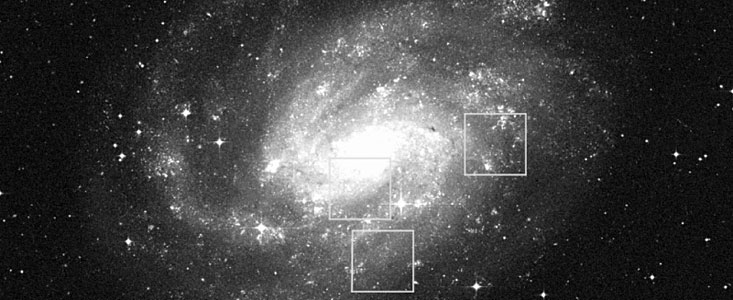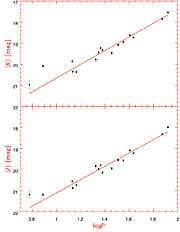Press Release
Moving Closer to the Grand Spiral
VLT Enables Most Accurate Distance Measurement to Spiral Galaxy NGC 300
1 August 2005
An international team of astronomers from Chile, Europe and North America [1] is announcing the most accurate distance yet measured to a galaxy beyond our Milky Way's close neighbours. The distance was determined using the brightness variation of a type of stars known as "Cepheid variables".
An international team of astronomers from Chile, Europe and North America [1] is announcing the most accurate distance yet measured to a galaxy beyond our Milky Way's close neighbours. The distance was determined using the brightness variation of a type of stars known as "Cepheid variables".
The team used the ISAAC near-infrared camera and spectrometer on ESO's 8.2-m VLT Antu telescope to obtain deep images in the near-infrared of three fields in the spiral galaxy NGC 300. Together these fields contain 16 long-period Cepheids. These stars had previously been discovered by the team in a wide-field imaging survey of this galaxy conducted with the Wide Field Imager (WFI) camera on the ESO/MPG 2.2-m telescope at La Silla.
The spiral galaxy NGC 300 is a beautiful representative of its class, a Milky-Way-like member of the prominent Sculptor group of galaxies in the southern constellation of the same name.
The astronomers derive a distance to NGC 300 of a little above 6 million light-years [2]. "The VLT data have led to accurate period-luminosity relations in the J- and K- bands, allowing us to determine the distance to NGC 300 with an unprecedented uncertainty of only three percent", says Wolfgang Gieren, of the University of Concepcion (Chile) and leader of the team. One of the reasons for this high accuracy was the opportunity to precisely combine the new near-infrared ISAAC data with the previous optical WFI data.
Cepheid variables constitute a key element in the measurement of distances in the Universe. It has been known for many years that the pulsation period of a Cepheid-type star depends on its intrinsic brightness (its "luminosity"). Thus, once its period has been measured, the astronomers can calculate its luminosity. By comparing this to the star's apparent brightness in the sky, they can obtain the distance to the star. This fundamental method has allowed some of the most reliable measurements of distances in the Universe and has been essential for all kinds of astrophysics, from the closest stars to the remotest galaxies.
This first Cepheid distance based on near-infrared imaging with the Very Large Telescope is a milestone in the team's Araucaria Project in which they seek to improve the local calibration of the distance scale with stellar standard candles, including Cepheid variables, by determining precisely how these standard candles depend on a galaxy's properties, such as its content in chemical elements and age.
Cepheids and the Distance Scale
Cepheid pulsating stars have been used as distance indicators since the early discovery of Henrietta Leavitt almost a hundred years ago. From her photographic data regarding one of the Milky Way's neighbour galaxies, the Small Magellanic Cloud, she found that the brightness of these stars closely correlate with their pulsation periods.
This period-luminosity relation, once calibrated, allows a precise distance determination of a galaxy once Cepheids have been discovered in it, and their periods and mean magnitudes have been measured.
While the Cepheid method doesn't reach out far enough in the Universe to directly determine cosmological parameters like the Hubble constant, Cepheid distances to relatively nearby resolved galaxies have laid the foundation for such work in the past, as in the Hubble Space Telescope Key Project on the Extragalactic Distance Scale. Cepheids indeed constitute one of the first steps in the cosmic distance ladder.
The current main problem with the Cepheid method is that its dependence on a galaxy's metallicity, that is, its content in elements more heavy than hydrogen and helium, has never been measured accurately so far. Another intriguing difficulty with the method is the fact that the total absorption of the Cepheid's light on its way to Earth, and in particular the amount of absorption within the Cepheid's host galaxy, must be precisely established to avoid significant errors in the distance determination.
Cepheid Variables in NGC 300
To tackle this problem, Wolfgang Gieren (University of Concepcion, Chile) and his team [1] devised a Large Programme at ESO: the Araucaria Project. Its aim is to obtain distances to relatively nearby galaxies with a precision better than 5 percent.
One of the key galaxies of the team's Araucaria Project is the beautiful, near face-on galaxy NGC 300 in the Sculptor Group. In a wide-field imaging survey carried out at the ESO/MPG 2.2-m telescope on La Silla in 1999-2000, the team had discovered more than a hundred Cepheid variables spanning a broad range in pulsation period. Pictures of the galaxy, and some of its Cepheids from these data were released in 2002. Last year, the team presented the distance of NGC 300 as derived from these optical images in V- and I-bands.
Moving to the Near-Infrared
The team complemented this unique dataset with new data taken with the ISAAC near-infrared camera and spectrometer on ESO's 8.2-m VLT Antu telescope.
"There are three substantial advantages in the Cepheid distance work when images obtained through near-infrared passbands are used instead of optical data", says Wolfgang Gieren. The most important gain is the fact that the absorption of starlight in the near-infrared, and particularly in the K-band, is dramatically reduced as compared to the effect interstellar matter has at visible wavelengths. A second advantage is that Cepheid light curves in the infrared have smaller amplitudes and are much more symmetrical than their optical counterparts, making it possible to measure a Cepheid's mean K-band brightness just from a very few, and in principle from just one observation at known pulsation phase. In contrast, optical work requires the observation of full light curves to determine accurate mean magnitudes. The third basic advantage in the infrared is a reduced sensitivity of the period-luminosity relation to metallicity, and to blending with other stars in the crowded fields of a distant galaxy.
Taking this into account, one of the main purposes of the team's Large Programme has been to conduct near-infrared follow-up observations of Cepheids in their project's target galaxies which have previously been discovered in optical wide-field surveys.
An Improved Distance Determination to NGC 300
Deep images in the J and K bands of three fields in NGC 300 containing 16 Cepheids were taken with VLT/ISAAC in 2003.
"The high quality of the data allowed a very accurate measurement of the mean J- and K- magnitudes of the Cepheids from just 2 observations of each star obtained at different times", says Grzegorz Pietrzynski, another member of the team, also from Concepcion.
Using these remarkable data the period-luminosity relations were constructed. "They are the most accurate infrared PL relations ever obtained for a Cepheid sample in a galaxy beyond the Magellanic Clouds", emphasizes Wolfgang Gieren.
The total absorption of light ("reddening") of the Cepheids in NGC 300 was obtained by combining the values for the distance of the galaxy obtained in the various optical and near-infrared bands in which NGC 300 was observed. This led to the discovery that there is a very significant contribution to the total reddening from absorption intrinsic to NGC 300. This intrinsic absorption has an important effect on the determination of the distance but had not been taken into account previously.
The team was able to measure the distance to NGC 300 with the unprecedented total uncertainty of only about 3 percent. The astronomers found that NGC 300 is located 6.13 million light-years away [2].
Notes
[1] The team is composed of Wolfgang Gieren (Principal Investigator of the Araucaria Project), Grzegorz Pietrzynski and Igor Soszynski (Universidad de Concepcion, Chile), Rolf-Peter Kudritzki and Fabio Bresolin (Institute for Astronomy, Hawaii, USA), Dante Minniti (Pontificia Universidad Catolica, Chile), and Jesper Storm (Astrophysikalisches Institut Potsdam, Germany).
[2] This distance determination is tied to an assumed distance of 163,000 light-years to the Large Magellanic Cloud (LMC). The accurate measurement of the LMC distance itself to which the extragalactic distance scale is currently tied will still require years of hard work.
More information
The information contained in this press release is based on a research article published in the August 1, 2005 issue of The Astrophysical Journal (The Araucaria Project: Near-Infrared Photometry of Cepheid Variables in the Sculptor Galaxy NGC 300). The Araucaria Project is a key activity of the Chilean FONDAP Center for Astrophysics.
Contacts
Wolfgang Gieren
Astronomy Group, Physics Department Universidad de Concepcion
Concepcion, Chile
Tel: +56 41 203103
Email: wgieren@astro-udec.cl
About the Release
| Release No.: | eso0524 |
| Legacy ID: | PR 20/05 |
| Name: | NGC 300 |
| Type: | Local Universe : Galaxy : Type : Spiral |
| Facility: | Very Large Telescope |
| Instruments: | ISAAC |
| Science data: | 2005ApJ...628..695G |


